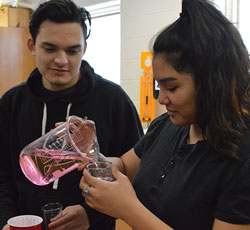There’s a slime-making craze oozing through preteen circles and leaving many a parent wondering, “Who ya gonna call?” when gooey trails are left on tables and goopy blots on countertops. The answer isn’t Ghostbusters but high school science teacher David Prindle.
In Prindle’s classroom, he will tell you, making slime is science, and a great way to teach about chemical processes– a Next Generation Science Standards requirement. Though many youngsters started DIY slime-making after watching YouTube and Instagram videos, Prindle has been making it with his students for years.

“It’s a fun way to get hands-on with stuff and show them how things compound together,” he said, while students in his Earth and Chemical Systems class stirred Elmer’s glue with Borax. He made things extra fun, challenging them to add water tinted with color from highlighter markers to give their slime a neon sheen and the ability to glow under a blacklight.
In Prindle’s class students stretched, plopped and squished their slime, considering their creations. “It’s messy,” said senior Ian Kohlhoff. “It’s something kids can do that’s safe. It’s nice being able to learn something and actually see it happen.”
Senior Vanessa Lezama said she likes toying with the consistency of slime, and said squeezing it offers comfort. “I like seeing the different strengths of the slime,” she said.
It also has offered a cool bonding experience in a non-chemical way. Prindle’s students recently made slime with help from their cognitively impaired peers, a suggestion from junior Nate Jones. “They are pretty cool kids. They are so sweet,” Nate said. “I thought they would enjoy something like that.”

The Basics
The recipe for slime includes white Elmer’s glue, which is made up of polyvinyl acetate, a polymer that “flows,” Prindle said. When mixed with water and Borax, or sodium tetraborate — a product with many household applications including laundry detergent — the polymers slow down and slime is formed. Creative children have taken the basic recipe and run with it, adding shaving cream, cornstarch, glitter, play sand, scents and other enhancements.
Borax can cause skin irritations if overused, but Pringle said making slime is not dangerous. Just don’t do it every day, he cautioned.
CONNECT













